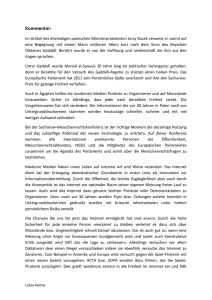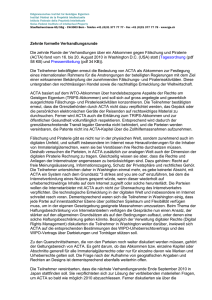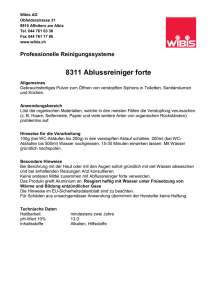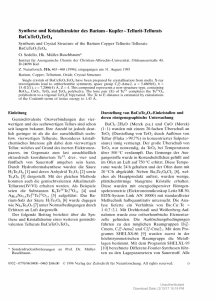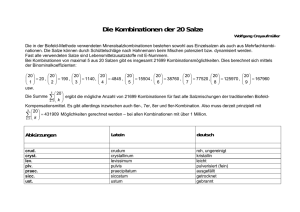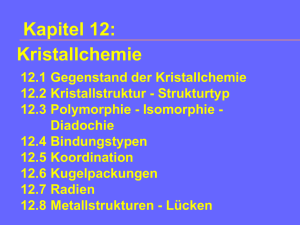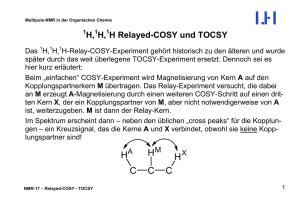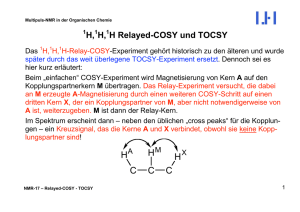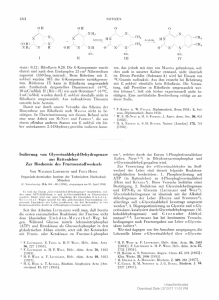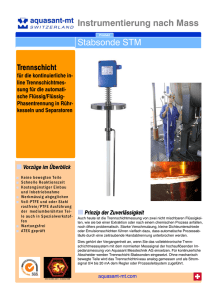International Union of Crystallography Book Reviews
Werbung
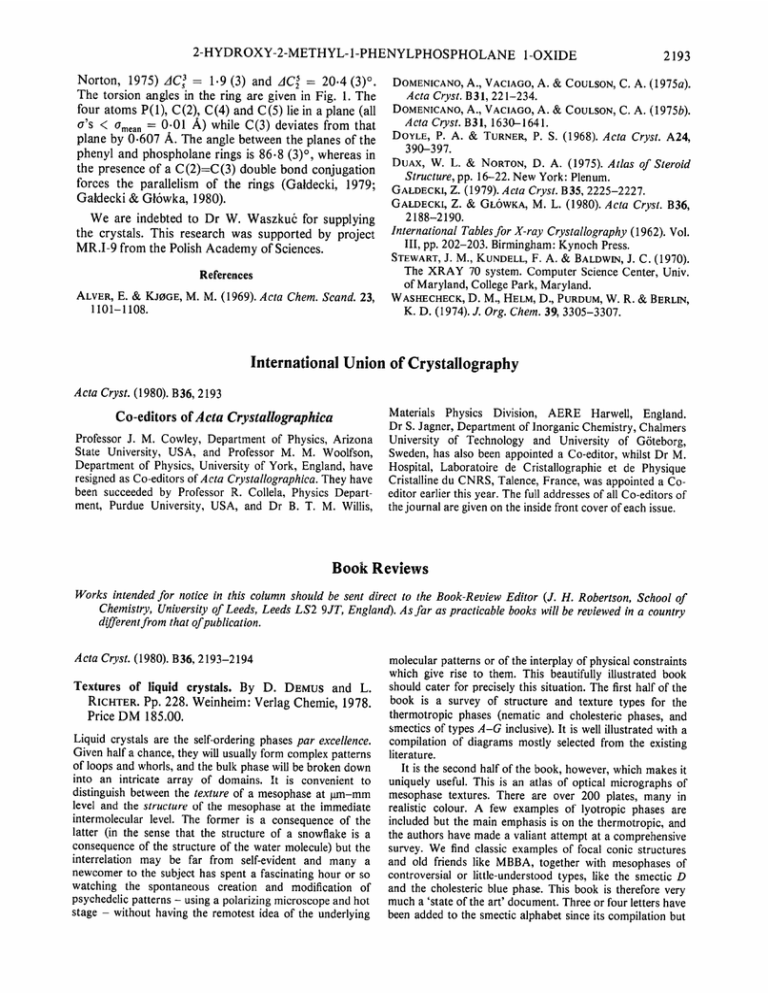
2-HYDROXY-2-METHYL- 1-PHENYLPHOSPHOLANE Norton, 1975) AC~ = 1.9 (3) and AC~ = 20.4 (3) °. The torsion angles in the ring are given in Fig. 1. The four atoms P(1), C(2), C(4) and C(5) lie in a plane (all o"s < O'mean~---0"01 /~) while C(3) deviates from that plane by 0.607 A. The angle between the planes of the phenyl and phospholane rings is 86.8 (3) °, whereas in the presence of a C ( 2 ) = C ( 3 ) double bond conjugation forces the parallelism of the rings (Gatdecki, 1979; Gatdecki & Gt6wka, 1980). We are indebted to Dr W. Waszku6 for supplying the crystals. This research was supported by project MR.I-9 from the Polish A c a d e m y of Sciences. References ALVER, E. & KJOGE, M. M. (1969). Acta Chem. Scand. 23, 1101-1108. 1-OXIDE 2193 DOMENICANO,A., VACIAGO,A. & COULSON,C. A. (1975a). Acta Cryst. B31, 221-234. DOMENICANO, A., VACIAGO,A. • COULSON, C. A. (1975b). Acta Cryst. B31, 1630-1641. DOYLE, P. A. & TURNER, P. S. (1968). Acta Cryst. A24, 390-397. DUAX, W. L. & NORTON, D. A. (1975). Atlas of Steroid Structure, pp. 16-22. New York: Plenum. GALDECKI, Z. (1979). Acta Cryst. B35, 2225-2227. GALDECKI, Z. & GL6WKA, M. L. (1980). Acta Cryst. B36, 2188-2190. International Tables for X-ray Crystallography (1962). Vol. III, pp. 202-203. Birmingham: Kynoch Press. STEWART,J. M., KUNDELL,F. A. & BALDWIN,J. C. (1970). The XRAY 70 system. Computer Science Center, Univ. of Maryland, College Park, Maryland. WASHECHECK, D. M., HELM, D., PURDUM,W. R. & BERLIN, K. D. (1974). J. Org. Chem. 39, 3305-3307. International Union of Crystallography Acta Cryst. (1980). B36, 2193 C o-editors of,4 eta Crystallographica Professor J. M. Cowley, Department of Physics, Arizona State University, USA, and Professor M. M. Woolfson, Department of Physics, University of York, England, have resigned as Co-editors of Acta Crystallographica. They have been succeeded by Professor R. Collela, Physics Department, Purdue University, USA, and Dr B. T. M. Willis, Materials Physics Division, AERE Harwell, England. Dr S. Jagner, Department of Inorganic Chemistry, Chalmers University of Technology and University of G6teborg, Sweden, has also been appointed a Co-editor, whilst Dr M. Hospital, Laboratoire de Cristallographie et de Physique Cristalline du CNRS, Talence, France, was appointed a Coeditor earlier this year. The full addresses of all Co-editors of the journal are given on the inside front cover of each issue. Book Reviews Works intended for notice in this column should be sent direct to the Book-Review Editor (J. H. Robertson, School of Chemistry, University of Leeds, Leeds LS2 9JT, England). As far as practicable books will be reviewed in a country different from that of publication. Acta Cryst. (1980). B36, 2193-2194 Textures of liquid crystals. By D. DEMUS and L. RICHTER. Pp. 228. Weinheim: Verlag Chemic, 1978. Price D M 185.00. Liquid crystals are the self-ordering phases par excellence. Given half a chance, they will usually form complex patterns of loops and whorls, and the bulk phase will be broken down into an intricate array of domains. It is convenient to distinguish between the texture of a mesophase at grn-mm level and the structure of the mesophase at the immediate intermolecular level. The former is a consequence of the latter (in the sense that the structure of a snowflake is a consequence of the structure of the water molecule) but the interrelation may be far from self-evident and many a newcomer to the subject has spent a fascinating hour or so watching the spontaneous creation and modification of psychedelic patterns - using a polarizing microscope and hot stage - without having the remotest idea of the underlying molecular patterns or of the interplay of physical constraints which give rise to them. This beautifully illustrated book should cater for precisely this situation. The first half of the book is a survey of structure and texture types for the thermotropic phases (nematic and cholesteric phases, and smectics of types A-G inclusive). It is well illustrated with a compilation of diagrams mostly selected from the existing literature. It is the second half of the book, however, which makes it uniquely useful. This is an atlas of optical micrographs of mesophase textures. There are over 200 plates, many in realistic colour. A few examples of lyotropic phases are included but the main emphasis is on the thermotropic, and the authors have made a valiant attempt at a comprehensive survey. We find classic examples of focal conic structures and old friends like MBBA, together with mesophases of controversial or little-understood types, like the smectic D and the cholesteric blue phase. This book is therefore very much a 'state of the art' document. Three or four letters have been added to the smectic alphabet since its compilation but 2194 BOOK REVIEWS features like this are inevitable in a subject with such fast-moving boundaries. In spite of its daunting price (of the order of £45 or $90), and the occasional clumsy translation, this is a book to be highly recommended for those practically concerned with liquid crystals. It fills a real need - close to one's elbow at the bench. But keep it away from your students if it should be the case that liquid crystals are not on their syllabus and you do not want their attention to be diverted: the lure of liquid crystals, so visually pleasing, scientifically interesting and technologically useful as well, is very strong! J.E. LYDON Department of Biophysics University of Leeds Leeds LS2 9JT England Acta Cryst. (1980). B36, 2194 Molekiilkristalle. Von A. I. KITAIGORODSKII. In deutscher Sprache herausgegeben von H. NEELS und G. KOHN. S. vii + 361, Abb. 172, Tab. 44. Berlin: Akademie-Verlag, 1979. Preis 68 M. Diese Monographie, in der es um die Kristallchemie und Kristallphysik organischer Molekfilverbindungen geht, ist eine erweiterte deutschsprachige Ausgabe des russischen Buches vom Jahre 1971. Ein paralleles Buch in englischer Sprache, Molecular Crystals and Molecules ist 1973 (in Academic Press) erschienen. In folgenden Aspekten wurde die deutsche Ausgabe erg~inzt bzw. fiberarbeitet: Behandlung fester L6sungen, elektrische Eigenschaften, Berechnung der freien Energie, sowie Konformation organischer Molekfile. Der Inhalt des Buches spiegelt wahrlich das Lebensschaffen von Professor Kitaigorodskii und seiner Schule wider. Somit wurde auch vom Autor bewusst darauf verzichtet, ein umfassendes Werk fiber die verschiedenen Richtungen und Anwendungen der organischen Kristallchemie zu schreiben. Grundkonzept des Buches ist die Anwendung des vom Autor vor mehr als dreissig Jahren entwickelten AtomAtom-Potentialmodells. Das erste Kapitel und somit die H/ilfte des Buches behandelt die beobachtete Struktur von organischen Molektilkristallen. Das Prinzip der dichten Packung und seine Bedeutung ffir eine Reihe von typischen organischen Kristallstrukturen (z.B. lineare aromatische Systeme, Normalparaffine, eisenorganische Verbindungen) wird in einer sehr klaren und ausffihrlichen Weise dargestellt. Dieser Teil der Monographie ist besonders den vielen organischen Chemikern zu empfehlen, die die R6ntgenstrukturanalyse heute weitgehend nur als analytische Methode verwenden. Ein besonderes Gewicht wird auf das experimentelle und theoretische Studium von bin~il'en Systemen (feste L6sungen) gelegt. Dagegen wird die Rolle yon Wasserstoffbrfickenbindungen in organischen Kristallstrukturen etwas stiefmfitterlich behandelt. Wenn man die entscheidende Bedeutung solcher Bindungen ffir die Struktur von vielen biologischen Molekfilen fiberlegt, ist es zumindest fiberraschend zu lesen, dass die organische Kristallchemie noch nicht fiber genfigend Daten verffigt, um aUgemeine Schlussfolgerungen fiber die intermolekularen Wasserstoffbr/ickenbindungen zu ziehen. Wasserstoffbrtickenbindungen zu anderen ais Sauer- und Stickstoffatomen werden nicht erw~ihnt. Kapitel 2 und 3 behandeln die Berechnung der Gitterenergie bzw. der Gitterdynamik von Molekfilkristallen. Grundlagen und Anwendung des Atom-AtomPotentialmodells werden ausffihrlich diskutiert. Als Beispiele werden Berechnungen an unpolaren Kohlenwasserstoffverbindungen dargestellt. Neuere Arbeiten an der Konformation und Packung von Nucleobasen, Polypeptiden und Proteinen werden allerdings nur sehr kurz erw/ihnt. Es fehlt deshalb eine Darstellung der Behandlung von elektrostatischen Wechselwirkungen und Polarisationsenergien bei polaren Molekfilen sowie die Berficksichtigung von Wasserstoffbrfickenbindungen. In Kapitel 4 werden Beugungs und KernresonanzMethoden zur Untersuchung der Struktur und Bewegung von Molekfilen kurz umrissen. Die wertvollen Kapitel 5 und 6 behandeln Thermodynamik vom Standpunkt theoretischer sowie experimenteller Untersuchungen. Die Behandlung der Messung und Berechnung von elastischen Eigenschaften von Ein- und Polykristallen ist besonders fibersichtlich. Mit der Herausgabe dieses Buches existiert in der deutschsprachigen Fachliteratur erstmals eine breit angelegte Darstellung zur Kristallchemie und KristaUphysik von organischen Verbindungen. Man muss bedauern, dass diese Ubersetzung fast 10 Jahre auf sich warten liess. Trotz Uberarbeitung beziehen sich nur ungef'~ihr 20% der Literaturstellen auf Arbeiten, die sp/iter als 1971 erschienen sind. F/ir viele potentielle Leser wird es wahrscheinlich ein ,~rgernis sein, dass die Namen der russischen Zeitschriften in dem Literaturverzeichnis nur in dem kyrillischen Alphabet gedruckt worden sind. Die Darstellung der Materie ist fiberaus klar und flfissig gehalten und die Monographie ist reichlich illustriert. Das Buch kann nicht nur Kristallographen sondern auch Chemikern als Einleitung in die organische Kristallchemie und Kristallphysik sowie als 0bersicht fiber die Forschungsarbeiten yon Professor Kitaigorodskii empfohlen werden. W. S. SHELDRICK Gesellschafl ffu'r Bioteehnologische Forschung mbH. D-3 300 Braunschweig-S t6ckheim Bundesrepublik Deutschland
